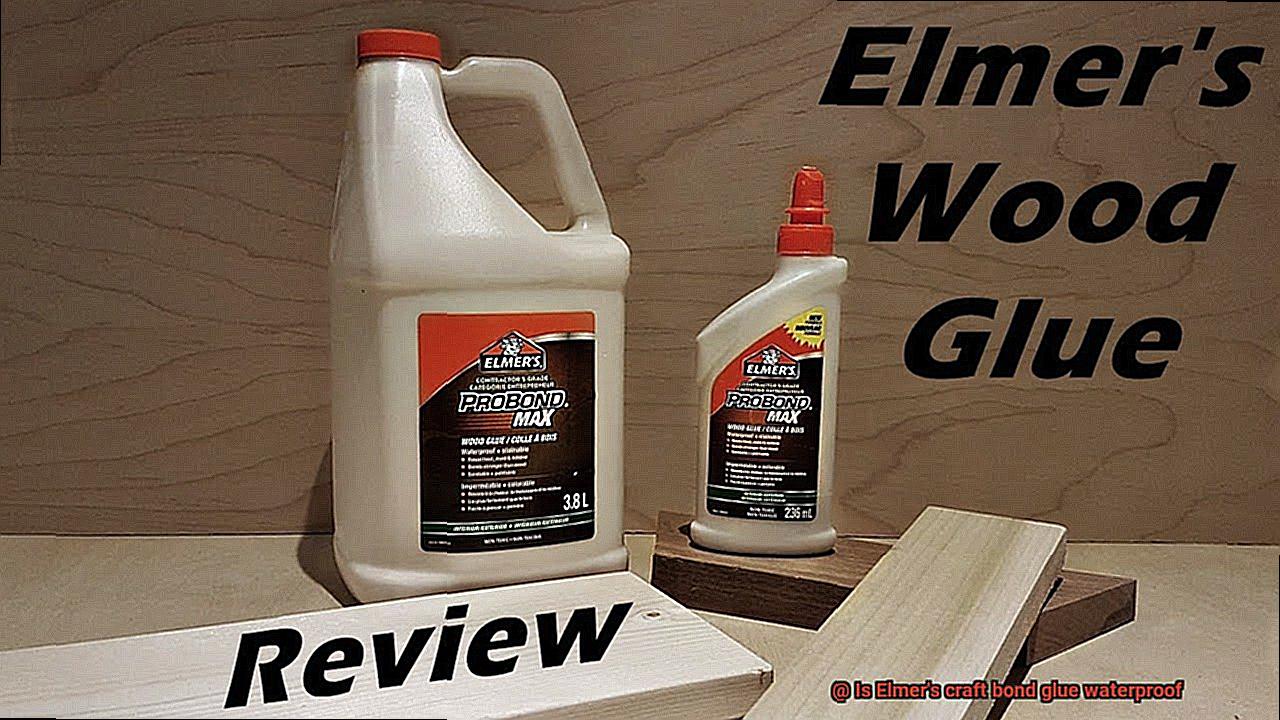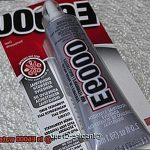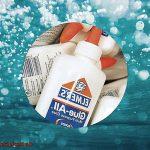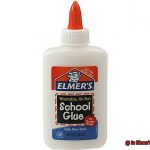Are you a craft enthusiast or DIYer who loves using Elmer’s craft bond glue? If so, you might be wondering if this versatile adhesive is waterproof. After all, when it comes to projects that may be exposed to moisture, like outdoor decor or costumes, waterproofing is key.
Well, the good news is that you’ve come to the right place. In this blog post, we’ll explore the ins and outs of Elmer’s craft bond glue and its water resistance properties. We’ll take a closer look at the glue’s formulation and how it affects its ability to withstand the elements.
But that’s not all – we’ll also share some tips and tricks for maximizing Elmer’s craft bond glue’s waterproofing capabilities. Whether you’re an experienced crafter or just starting out, this post will give you everything you need to know about creating crafts that can brave even the harshest weather conditions.
So get ready to dive deep into the world of Elmer’s craft bond glue and waterproofing. By the end of this post, you’ll have all the knowledge and tools necessary to create durable, waterproof crafts that are sure to impress.
Different Types of Elmer’s Craft Bond Glue
Contents
- 1 Different Types of Elmer’s Craft Bond Glue
- 2 Is Elmer’s Craft Bond Glue Waterproof?
- 3 Factors Affecting the Water-Resistance of Elmer’s Craft Bond Glue
- 4 How to Apply Elmer’s Craft Bond Glue for Optimal Results
- 5 Tips for Working with Elmer’s Craft Bond Glue
- 6 Alternatives to Elmer’s Craft Bond Glue
- 7 Conclusion
With a range of types available, each with its unique properties and uses, you’re sure to find the perfect glue for your project.

For lightweight materials like paper, fabric, and foam, the Multi-Purpose Spray Adhesive is an excellent choice. It dries quickly and forms a clear, flexible bond that won’t yellow over time. Keep in mind that this glue is not waterproof and shouldn’t be used on items that will get wet.
When it comes to heavy-duty bonding, the Extra Strength Glue Stick is the way to go. Ideal for materials like wood, metal, plastic, and ceramics, it dries clear and strong. However, also note that it’s not waterproof.
If you’re working on woodworking projects, Elmer’s Craft Bond Wood Glue Max is specifically designed for you. It provides a strong bond and can withstand heat and water exposure. Plus, it’s waterproof and can be sanded or painted over once it dries.
If you want a versatile adhesive for both fabrics and paper materials that provides a permanent bond that can withstand washing, try the Elmer’s Craft Bond Fabric and Paper Glue. This glue is also waterproof and dries clear.
For non-toxic bonding on a variety of materials like paper, wood, metal, ceramics, and plastics, the Elmer’s Craft Bond Tacky Glue is an excellent option. Drying clear and remaining flexible after drying, it is waterproof and ideal for both indoor and outdoor projects.
Remember to read the label carefully when selecting the right type of Elmer’s Craft Bond Glue for your project. Applying it evenly and allowing it to dry completely before exposure to water will increase its chance of staying intact even when exposed to moisture or water.
Is Elmer’s Craft Bond Glue Waterproof?
Well, let me tell you, it’s not a simple yes or no answer.
Firstly, Elmer’s Craft Bond Multi-Purpose spray adhesive is not waterproof. It’s ideal for lightweight materials such as paper and fabric, but exposure to water or moisture may weaken or break down the bond. So if you’re planning on creating a craft that will come into contact with water, you may want to reconsider this option.
But don’t lose hope just yet. Elmer’s Craft Bond Ultra Stix All adhesive is designed to be water-resistant and can withstand exposure to moisture without breaking down. This adhesive is perfect for heavy-duty projects involving wood, metal, plastic, and ceramics. It’s a great option for those who need a strong bond that can handle some moisture without weakening.
However, there’s a catch. Although Elmer’s Craft Bond Ultra Stix All adhesive is water-resistant, it’s not completely waterproof. Prolonged exposure or submersion in water may cause the bond to weaken over time. So if you need a completely waterproof bond for your project, you may want to consider other options.
Factors Affecting the Water-Resistance of Elmer’s Craft Bond Glue

When it comes to determining the water-resistance of Elmer’s Craft Bond Glue, several factors come into play.
The first factor is the type of surface on which the glue is applied. Elmer’s Craft Bond Glue works wonders on porous surfaces such as paper, cardboard, and fabric. These materials easily absorb the glue, creating a strong bond that can withstand light exposure to water.
Another crucial factor that influences the water-resistance of Elmer’s Craft Bond Glue is the amount of glue applied. Applying too little glue may not provide enough adhesive strength to withstand water exposure. On the other hand, applying too much glue can result in a weak bond that breaks down when exposed to water.
The drying time of Elmer’s Craft Bond Glue also plays a vital role in its water-resistance. The glue requires at least 30 minutes to dry completely, but for maximum strength, it’s recommended to let it dry for 24 hours before exposing it to water. Rushing the drying process may lead to a weak bond that breaks down when exposed to water.
Environmental factors such as temperature and humidity can also affect the water-resistance of Elmer’s Craft Bond Glue. High temperatures and humidity can cause the glue to dry too quickly, resulting in a weak bond that breaks down when exposed to water. Conversely, low temperatures and low humidity can slow down the drying process, preventing the glue from forming a strong bond that can withstand water exposure.
How to Apply Elmer’s Craft Bond Glue for Optimal Results
Here are five easy steps to follow that will help you achieve the best bond possible.
Step 1: Clean and Dry Surfaces
Before applying Elmer’s Craft Bond Glue, it’s essential to ensure that the surfaces you’re bonding are clean and dry. Any dust, debris or moisture can affect the strength of the bond. To avoid this, wipe them down with a clean, dry cloth before applying the glue.
Step 2: Apply a Thin Layer
The key to achieving a strong bond is to apply a thin layer of glue on one of the surfaces using a brush or applicator. Be careful not to apply too much glue as it can weaken the bond. Spread the glue evenly and make sure you cover the entire surface without leaving any gaps or bubbles.
Step 3: Press Surfaces Together
After applying the glue, press the two surfaces firmly together and hold them in place for a few seconds. This helps to ensure that the bond sets properly. If you’re working with heavier materials or need a more permanent bond, consider using clamps or weights.
Step 4: Allow Glue to Dry
It’s important to allow the glued item to dry completely before handling it or exposing it to any stress. The drying time may vary depending on factors such as humidity and temperature but generally takes between 30 minutes to an hour. Be patient and avoid disturbing the bond until it has dried completely.
Step 5: Store Glue Properly
To preserve Elmer’s Craft Bond Glue’s effectiveness, store it in a cool, dry place and avoid exposing it to extreme temperatures or sunlight. Always ensure that you tightly seal the container after use to prevent drying out of the glue.
With these simple steps, you can achieve optimal results when using Elmer’s Craft Bond Glue for a variety of crafting and DIY projects. Remember to choose the appropriate type of glue for your project and read the label carefully before use.
Tips for Working with Elmer’s Craft Bond Glue
Here are five expert tips to help you make the most of this versatile adhesive.
Choose the Right Formula for Your Project
Elmer’s Craft Bond Glue comes in several different formulas, each designed for specific materials and purposes. Whether you’re working with delicate fabrics or woodworking projects, there’s a formula that’s perfect for your needs. By selecting the appropriate formula, you’ll ensure that your project stays intact and looks great.
Apply Thin Layers of Glue
One of the keys to success with Elmer’s Craft Bond Glue is applying it in thin layers rather than thick blobs. This allows the glue to dry faster and form a stronger bond with the surface it’s applied to. Plus, it helps prevent warping or wrinkling of paper or fabric.
Allow for Drying Time
Elmer’s Craft Bond Glue requires some drying time to set properly. It is recommended to wait at least 24 hours before handling the glued item. This will ensure that the bond is strong and durable.
Store Properly
To keep your glue effective, it’s important to store it properly. Keep it in a cool, dry place and always make sure the cap is tightly closed. This will prevent the glue from drying out or becoming less effective over time.
Clean Up Excess Glue Immediately
If you accidentally apply too much glue or get it on surfaces where you don’t want it, use a damp cloth or sponge to clean it up immediately. This will prevent the glue from drying and becoming difficult to remove later on.
While Elmer’s Craft Bond Glue is not advertised as waterproof, it does have some water-resistant properties. However, if you need a truly waterproof adhesive for your project, it is recommended to use a specialized waterproof glue instead.
Alternatives to Elmer’s Craft Bond Glue
Crafting and DIY projects are a fantastic way to unleash your creativity, but finding the right glue is crucial. Although Elmer’s Craft Bond Glue is a go-to for many, it may not be the best fit for everyone. Luckily, there’s no need to stick with just one option. Here are several alternatives to consider that may better suit your needs.
For a reliable option, Aleene’s Original Tacky Glue is an excellent choice. It’s renowned for its strong hold and ability to dry clear, making it perfect for various crafting projects. Plus, it’s non-toxic, so it’s safe for all ages to use. Additionally, its water-resistant properties make it ideal for projects that may come into contact with moisture.
Need something that dries quickly and provides a solid hold? Look no further than Gorilla Super Glue. It works wonders on a variety of surfaces such as wood, metal, and plastic, thanks to its fast-drying formula and impressive bonding strength. It’s also water-resistant and can withstand exposure to both hot and cold temperatures.
If you’re searching for an eco-friendly alternative, E6000 Craft Adhesive is a wise choice. This glue boasts industrial-strength bonding capabilities and can bond to various surfaces like fabric and leather. Moreover, it’s waterproof and heat-resistant, making it perfect for outdoor projects.
Don’t forget about other alternatives such as Beacon Fabri-Tac Permanent Adhesive, Mod Podge Waterbase Sealer, Glue Dots Mini Dots, and Scotch Quick-Drying Tacky Glue.
When choosing an alternative to Elmer’s Craft Bond Glue, keep in mind factors such as strength, drying time, water-resistance, and eco-friendliness. By doing so, you’ll find the perfect glue to suit your crafting needs.
Also Read: Is Elmer’s Glue Waterproof?
Conclusion
In summary, Elmer’s Craft Bond Glue is a versatile adhesive that caters to different needs. Its range of products offers unique properties and uses, making it easy to find the perfect fit for your project. While some types may not be waterproof, others like the Elmer’s Craft Bond Ultra Stix All adhesive are water-resistant and can handle moisture exposure without breaking down.
However, it’s worth noting that prolonged submersion or exposure to water can weaken the bond over time. Environmental factors such as temperature and humidity also affect its water-resistance capabilities. Therefore, it’s essential to read the label carefully and select the right type of glue for your project.
To achieve optimal results when using Elmer’s Craft Bond Glue, ensure that surfaces are clean and dry before applying a thin layer of glue on one surface using a brush or applicator. Firmly press surfaces together and allow them to dry completely before handling or exposing them to any stress.
If Elmer’s Craft Bond Glue doesn’t meet your needs, there are plenty of alternative options available like Aleene’s Original Tacky Glue, Gorilla Super Glue, E6000 Craft Adhesive, Beacon Fabri-Tac Permanent Adhesive Mod Podge Waterbase Sealer among others. When selecting an alternative glue option for your project consider factors such as strength, drying time, water-resistance and eco-friendliness.






